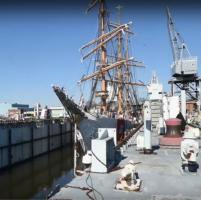 Here is a time-lapse video of the U.S. Coast Guard’s 81-year-old Barque Eagle departing the floating drydock, the ex-USS Oak Ridge, on February 27, 2018, at the Coast Guard Yard, Baltimore, Maryland.
Here is a time-lapse video of the U.S. Coast Guard’s 81-year-old Barque Eagle departing the floating drydock, the ex-USS Oak Ridge, on February 27, 2018, at the Coast Guard Yard, Baltimore, Maryland.
The 295-foot Eagle went on dock in August of 2017, to complete the fourth and final phase of a service life extension project under the Coast Guard’s in-service vessel sustainment program. While in the drydock repairs to the mechanical and electrical systems were completed, was well inspections and structural repairs. The work should provide an additional decade of service life for the historic training vessel, and will allow America’s Tall Ship Eagle to train the Coast Guard’s future officers for years to come. Eagle will now return to the Coast Guard Academy for its summer ports of call.
USCGC Eagle (WIX-327), was built in 1936 as a German sail training ship originally named Horst Wessel. Following World War II, it was taken by the U.S. as war reparations. Eagle serves as a training cutter for future officers of the United States Coast Guard. She is the only active commissioned sailing vessel in U.S. military service.

Never heard it called a “floating drydock”.
We had drydocks at the ship yard that could be filled with water to sail the ship out.
Huzzah for the “Eagle” — sail on!
Coming from “Phil” a prolific nautical affairs commenter one was very surprised that he had never heard of “floating drydocks”.
It is the usual term used to distinguish them from the Graving drydocks common in UK, its Commonwealth countries and the EU. Nowadays floating drydocks are common worldwide and while convenient Graving drydocks are much safer to use, in this seafarers opinion.
Floating drydocks are much more complex to use than a Graving drydock since one is putting a floating vessel into a floating vessel. The problem is threefold. The stability of the floating drydock throughout the operation, the stability of the vessel throughout and the stability of the relationship between the two throughout.
During my 50 year career I had to do the calculations on several occasions and without computers one might add. Working it all out using mathematic log tables was labourious work, I never felt comfortable using a “Ralston” Indicator. The main points were preventing the loss of GM of both floating drydock and the vessel throughout and the “Uptrust” which is when the vessel entering actually touch’s the drydock blocks, usually stern first. This latter is heart stopping when entered into a floating drydock as the ship is depending on the calculations of the floating drydock superintendent. If not correct the two units may list violently and suddenly as has happened on occasions. Well lecture over !!
Good Watch.
Not to belabor the point but if one enters “drydock disasters” in Youtube® there are a variety of illustrations of problems.
Good Watch.
Thanks to the experienced comments for some further insight on both dry-docking methods.